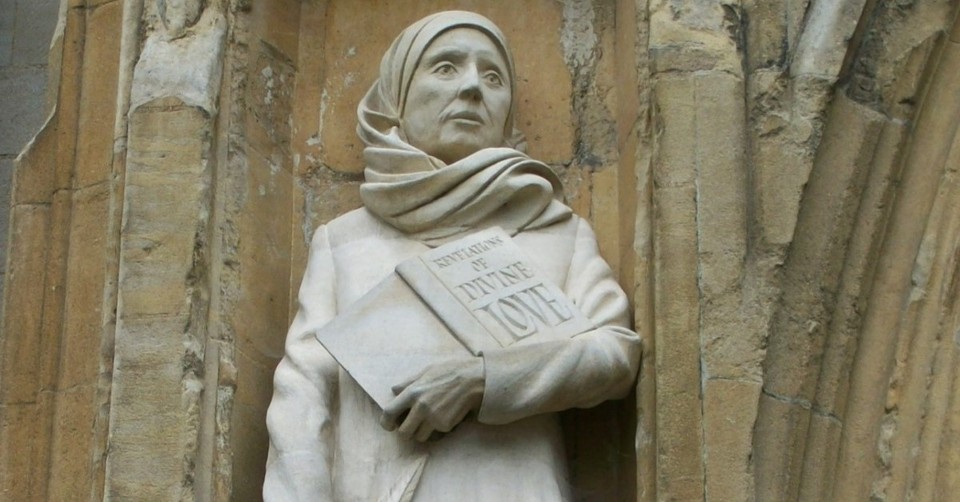What Can We Learn from Julian of Norwich Today?

Have you ever questioned whether God was love when you were going through a difficult time? Have you ever felt you were standing alone in support of truth? What’s that got to do with Julian of Norwich? Everything.
Julian of Norwich was a woman who had a vision from God and wrote it down. That doesn’t sound all that impressive by modern standards, but it is remarkable, considering she lived during medieval times. Her book is the first book known to be written in English (Middle English), and she was the first woman to write a book in English that has survived. Her work continues to influence modern writers and theologians today with its testament to the love of God.
You may be wondering how the life of Julian of Norwich is relevant to modern life, but we have a lot more in common with her environment than you might think. She lived through two plagues. The first one killed 75% of the population of Norwich when she was a child, and the second killed 75% of the children when she was a young woman. By age thirty, she had entered a residence at the Church of St. Julian in Norwich. Specifically, she entered as an anchoress—someone who vows to live the life of a hermit within her room adjacent to the church for the rest of her life.
Important Events in the Life of Julian of Norwich
Julian of Norwich, also known as Dame Julian or Lady Juliana of Norwich, was born in 1342. According to the World History Encyclopedia, her actual name and many details of her earlier life are unknown. Some say she was probably a widow and may have given birth to a child who died. She became an anchoress at St. Julian’s and lived in relative seclusion the rest of her life, taking her name from the church where she lived.
While an anchoress lived the life of a hermit, they were allowed to speak to the outside world. Her room had two small windows. One opened into the church, allowing her to participate in mass services and receive communion and food. The other window opened onto the street, where she received visitors for prayer and counseling. She was known as a woman of prayer and wisdom.
According to Friends of Julian of Norwich, at 30 and a half years old (1373), she became deathly ill and had a vision of Christ bleeding and received insights into his suffering and his love for us. When she recovered from the illness, she was moved to write down what she had seen to share it with others.
How Many Books Did Julian of Norwich Write?
Julian of Norwich only wrote one book: Revelations of Divine Love.
There are two versions of the text. A short version was written soon after her recovery from illness. A longer version was written over the 20 years following the vision. It consists of 16 chapters relating to different aspects of Christ’s suffering and the nature of God.
How Did Julian of Norwich Change Theology?
Julian of Norwich lived during a time when mysticism was flourishing in Christian Europe. The new interest in mysticism lasted from the middle of the thirteenth century until the middle of the fifteenth century.
The mystics, such as Meister Eckhart and Margery Kempe, encouraged spiritual revival amid the Black Death, church corruption, and political upheavals such as the Peasant’s Rebellion. Many medieval clerics saw the Black Death as God’s punishment for sin and promoted the image of a vengeful God pouring out His wrath. On the other hand, the mystics hoped to draw people into a deeper spiritual relationship with God on a personal level rather than living in fear of Him.
Julian of Norwich wrote her Revelations of Divine Love after praying that she could receive three graces from God: to have a recollection of Christ’s Passion, to have a bodily sickness so severe it should appear mortal, and to have three wounds from God: remorse, compassion, and longing for God. Her illness at thirty and a half years old did indeed appear mortal, and she received her last rites. It was on what she thought was her deathbed that she received the sixteen revelations from God.
She had a vision of Christ’s passion and suffering. In contrast to her contemporaries, Julian understood God as a God of love who understands and offers acceptance to those who accept the sacrifices of Christ. She maintained that “all would have been well” if not for sin in the world, but because of sin, Jesus had to suffer and die, and everyday people had to suffer and die. One of the most quoted phrases from her writing is, “All will be well, and all will be well, and every kind of thing will be well.” No matter what is happening to us, God will one day make it all well, even if it is on the other side of eternity.
She compares God’s love to a mother’s love: through Christ, we gain a spiritual birth as the motherhood of creation. She also saw God as the All-Mother nurturing her children and drawing people to a relationship with Him for a higher purpose. It is about a deeper relationship between God and His creation, His children, because of His great love for us.
Another image was that the world was like a hazelnut in God’s hand. Out of this image, she recognizes three truths:
- God created the hazelnut
- God loved the hazelnut
- God looks after the hazelnut from moment to moment.
Who Did Julian of Norwich Influence?
Julian of Norwich has influenced several poets and writers—both contemporaries and people born after her time.
Margery Kempe, a contemporary mystic of Julian’s time, was known to have taken counsel with her.
The modernist poet T. S. Eliot quoted Julian of Norwich’s “all will be well” phrase as a closing to Little Gidding, the last of his Four Quartets.
Denise Levertov wrote several poems about Julian of Norwich, including “St. Julian and the Shepherd” and “Annunciation.”
Julian of Norwich also influenced Iris Murdoch’s philosophy and fiction.
Scholars have compared Annie Dillard’s spiritual writings to Julian of Norwich, discussing whether Dillard tried to emulate Julian on several levels.
What Can We Learn from Julian of Norwich Today
Some may wonder how Julian of Norwich’s life relates to us.
For one thing, her situation—a world in upheaval, living in isolation—was not unlike some struggles we experience today. The COVID-19 pandemic caused huge upheavals not so long ago, and much of the population went into lockdown for months. Many continued to “shelter in place” even after the situation became moderately stable. Disturbing statistics and predictions filled our discussions. Many people were afraid. Others were angry.
Julian of Norwich took voluntary isolation for religious obligations, not health concerns. Still, the struggles she would have experienced—getting used to being isolated from other people, the contrast between the isolation and the chaotic world outside—are ones we can relate to today. She could easily have despaired. However, she chose to focus on Christ and be a counselor to those suffering and struggling. While we may not relate to all her circumstances, we can still learn things from her attitude, her life, and what she did with the time she had.
Her name may not be a household name or even one recognized in many modern churches, but there is something to be said of her vision of God: a God who loves, whose love shines through the world’s suffering and death. Theodicy is the defense of God in the face of suffering. Julian of Norwich did an excellent job of showing theodicy’s claim that suffering is a direct result of a fallen world, and yet somehow, by God’s grace, the suffering has spiritual benefits. In the end, Julian maintains that God is love, and we can rest in the truth that “all will be well” because God holds everything in the palm of His loving hand.
If you would like to read more about other little-known women in the Bible or Christian history, check out the following articles:
Women in the Bible All Christians Should Know
How Did Hildegard of Bingen Change Medieval Christianity?
What Should You Know about Puritan Poet Anne Bradstreet?
What Should You Know about Christian Poet Christina Rossetti?
Why Was Susanna Wesley the Mother of Methodism?
Lottie Moon: The Southern Belle Who Went to China
Photo Credit: Public Domain photo via Wikimedia Commons
Linda Lyle is a writer, teacher, knitter, and unintentional collector of cats. She has written articles for the Alabama Baptist, Open Windows, Refresh, as well as multiple novels and novellas. Her newest book, 5-Minute Prayer Plan for When Life Is Overwhelming, is set to release in October. She spins yarns on her blog The End of My Yarn at lindalyle.com.
Originally published November 01, 2023.







